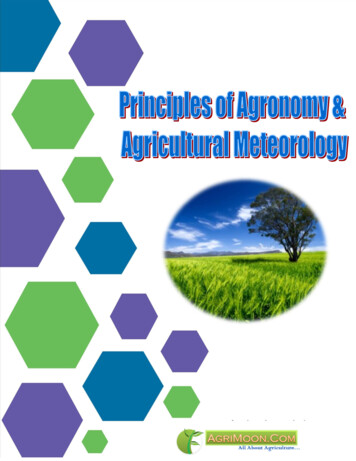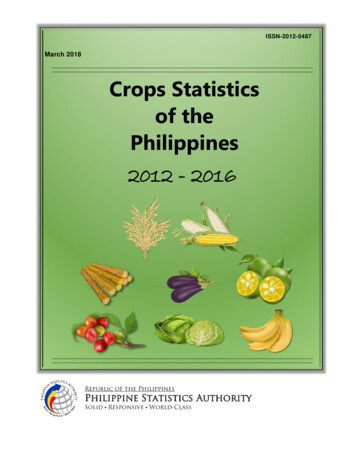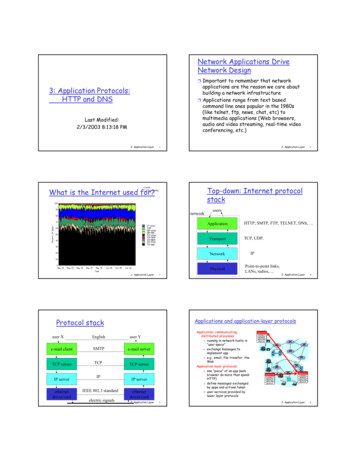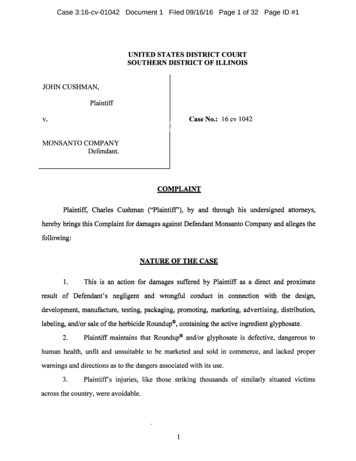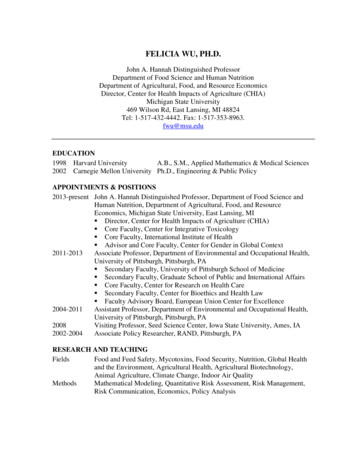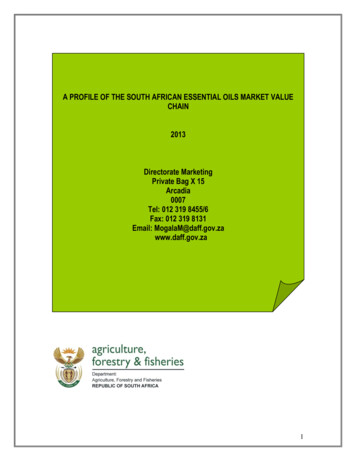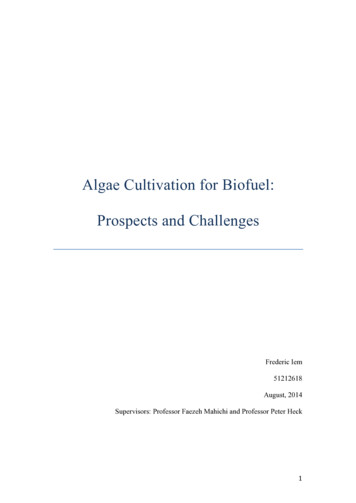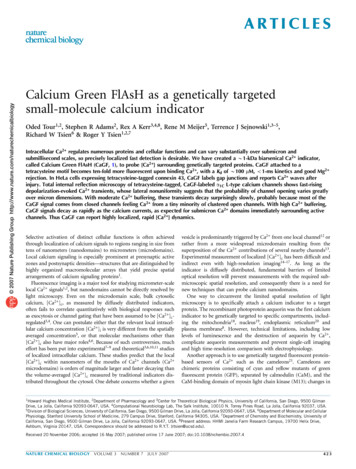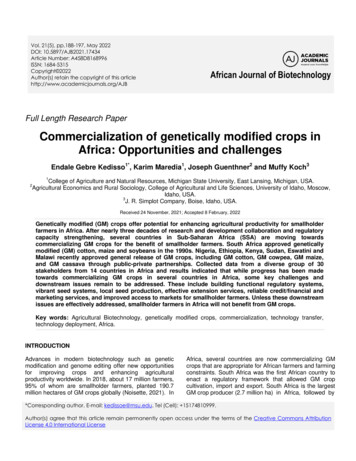
Transcription
Vol. 21(5), pp.188-197, May 2022DOI: 10.5897/AJB2021.17434Article Number: A458D8168996ISSN: 1684-5315Copyright 2022Author(s) retain the copyright of this articlehttp://www.academicjournals.org/AJBAfrican Journal of BiotechnologyFull Length Research PaperCommercialization of genetically modified crops inAfrica: Opportunities and challengesEndale Gebre Kedisso1*, Karim Maredia1, Joseph Guenthner2 and Muffy Koch31College of Agriculture and Natural Resources, Michigan State University, East Lansing, Michigan, USA.Agricultural Economics and Rural Sociology, College of Agricultural and Life Sciences, University of Idaho, Moscow,Idaho, USA.3J. R. Simplot Company, Boise, Idaho, USA.2Received 24 November, 2021; Accepted 8 February, 2022Genetically modified (GM) crops offer potential for enhancing agricultural productivity for smallholderfarmers in Africa. After nearly three decades of research and development collaboration and regulatorycapacity strengthening, several countries in Sub-Saharan Africa (SSA) are moving towardscommercializing GM crops for the benefit of smallholder farmers. South Africa approved geneticallymodified (GM) cotton, maize and soybeans in the 1990s. Nigeria, Ethiopia, Kenya, Sudan, Eswatini andMalawi recently approved general release of GM crops, including GM cotton, GM cowpea, GM maize,and GM cassava through public-private partnerships. Collected data from a diverse group of 30stakeholders from 14 countries in Africa and results indicated that while progress has been madetowards commercializing GM crops in several countries in Africa, some key challenges anddownstream issues remain to be addressed. These include building functional regulatory systems,vibrant seed systems, local seed production, effective extension services, reliable credit/financial andmarketing services, and improved access to markets for smallholder farmers. Unless these downstreamissues are effectively addressed, smallholder farmers in Africa will not benefit from GM crops.Key words: Agricultural Biotechnology, genetically modified crops, commercialization, technology transfer,technology deployment, Africa.INTRODUCTIONAdvances in modern biotechnology such as geneticmodification and genome editing offer new opportunitiesfor improving crops and enhancing agriculturalproductivity worldwide. In 2018, about 17 million farmers,95% of whom are smallholder farmers, planted 190.7million hectares of GM crops globally (Noisette, 2021). InAfrica, several countries are now commercializing GMcrops that are appropriate for African farmers and farmingconstraints. South Africa was the first African country toenact a regulatory framework that allowed GM cropcultivation, import and export. South Africa is the largestGM crop producer (2.7 million ha) in Africa, followed by*Corresponding author. E-mail: kedissoe@msu.edu. Tel (Cell): 15174810999.Author(s) agree that this article remain permanently open access under the terms of the Creative Commons AttributionLicense 4.0 International License
Kedisso et al.Sudan (243,000 ha), Ethiopia (1,300 ha in 2021),Eswatini (250 ha) and Kenya (1500 ha in 2021) (Silas etal., 2022; USDA, 2020; ISAAA, 2018). To date, thegovernments of 12 countries in SSA have a functionalbiosafety regulatory framework. The governments ofseven countries - Ethiopia, Eswatini, Kenya, Malawi,Nigeria, South Africa and Sudan - have approved thegeneral release of GM crops (Turnbull et al., 2021;Gbashi et al., 2021).Currently, there are 13 GM crops in different stages ofresearch and development in 13 African countries, with13 different traits (ISAAA, 2018). Cotton (Gossypiumspp.), maize (Zea mays), cowpea (Vigna sinensis), rice(Oryza sativa), sorghum (Sorghum bicolor), potato(Solanum tuberosum), sweet potato (Ipomea batatus),cassava (Manihot esculenta), banana (Musa sapientum)and sugarcane (Saccharum officinarum) are either beingtested in confined field trials (CFT) or are approved forgeneral release (Akinbo et al., 2021). Since 2018, fourcountries have initiated commercial production afterapproval for general release (ISAAA, 2020): Ethiopia (Btcotton), Malawi (Bt cotton), Kenya (Bt cotton) and Nigeria(Bt cotton and insect resistant cowpea). Burkina Fasoand Egypt, both earlier adopters of GM crops, facedchallenges after commercialization and suspendedproduction. In Burkina Faso, Bt cotton commercialproduction was suspended in 2016 due to fiber quality.Egypt suspended production of GM maize through aMinisterial decree in 2012 (Turnbull et al., 2021) overconcerns about trade with the EU.Overall, close to three million hectares of GM cropswere planted across Africa in 2021. Despite considerableglobal advancement of GM crops, progress incommercialization in Africa has been slower thanexpected (Gbashi et al., 2021; Azadi et al., 2015). Afternearly three decades of safe use of GM crops anddocumented benefits for smallholder farmers (Kouser andQiam, 2011; Bennett et al., 2006), governments of manyAfrican countries are still debating and delaying the useof GM crops.Numerous reports from health and environmentalsafety research have confirmed the safety and benefits ofGM crops and their derived products (Gbashi et al., 2021;Oloo et al., 2020; Bayer Crop Science, 2020; EU Report,2010; ISAAA Biotech Update, 2010). Such scientificevidence has not removed lingering public perceptionand controversies about the environmental and foodsafety concerns of GM crops (Mbabazi et al., 2016).Public safety concerns have limited GM cropdevelopment, and there are many other barriers tocommercialization of already approved products. AfterCFT, which focus on event selection and regulatory datacollection, GM cultivars, like conventional cultivars, aresubject to further evaluation through nationalperformance trials (NPTs) and verification studies to meetnational cultivar release requirements (Akinbo et al.,1892021). National research programs, biosafety authoritiesand other regulatory agencies work in parallel to evaluatesafety and performance results, complete riskassessments, release and register GM crops.After safety approval and cultivar registration, the rolesof regulators diminish and commercialization processesbecome the focus. The private sector, seed systems,extension systems and business methods function todeploy new GM crops and this transition to commercialdeployment is complex and rarely smooth. In Africa,commercialization needs to take into account theprevalence of an informal seed sector, the importanceand needs of smallholder farmers, the role of the publicsector in producing and supplying improved plantingmaterial and extension services, and how the privatesector will work alongside these systems. Additionalcommercialization responsibilities for GM crops must beaddressed, including the promotion of new products,obtaining wider acceptance for GM technology, ensuringfarmer access to sustainable new products, maintainingproduct quality and responsible introduction throughstewardship.Roadmap for commercialization of GM cropsSince the first field trial of a GM product in South Africa in1989, progress has been made on the adoption ofbiotechnology products. In Africa, the number oflaboratory and field trials for product development hasincreased reflecting scientific optimism for the benefits ofthe GM crops in the midst of prolonged controversysurrounding modern biotechnology (Waithaka et ization, product stewardship is implementedacross the process to support the responsible release ofsafe, innovative GM products (ETS, 2017).Bringing a conventional or GM crop cultivar to marketrequires many years of systematic development, testing,and selection. Private and public sector developers applystepwise review and decision-making processes tomonitor the development of new products and to ensurethat only good events are moved through tocommercialization and into the hands of farmers. tion ensure that important considerationsare investigated at each step of development (Cooper,2006). Re-evaluation takes place at the end of eachdevelopment step for each product. This reevaluationincludes a review of product performance, business fitwith existing strategy goals, marketing plans, intellectualproperty management and licensing, mmercialization strategy.Input on each of these areas informs the Yes/Nodecisions that are essential for effective product
190Afr. J. Biotechnol.Figure 1. Outline of a product commercialization process for a GM plant cultivar.development (Figure 1). At all the decision meetings, theproduct data are reviewed and a decision is made onwhether to continue or halt the development of theproduct. Sometimes a decision to continue may include astep back to repeat and address certain activities that willhelp ensure the quality needed for a successful product.Successful commercialization of a GM cultivar requiresa well-planned strategy with input from experts in a widerange of fields such as agronomy, molecular ip, seed production, communication, business,marketing, economics, environmental sciences and socialsciences. Coordination of the steps and expert inputrequires effective project management and clear criteriafor the decisions that are taken at each step in thedevelopment process. Missing one area of expert input orindecisive decision-making at any one stage can lead tocostly oversights and a considerable waste of money andtime. In general, the process outlined in Figure 1 takes 10to 15 years and can cost upwards of US 50 million for anew GM cultivar depending on the crop, traits,technology, markets, and efficiency of the regulatoryapproval processes.Since GM crop commercialization in the mid-1990s,enhanced capacity for regulatory compliance and productstewardship became critical to help ensure safe andsustainable use of biotechnology products. Effort wasmade in some countries to establish research anddevelopment capacity, which are lacking in most countriesin Africa. Stakeholders have identified several factorscausing delay to commercialization of GM crops,including socio-economic constraints, high cost oftechnology or seed, fear of corporate monopoliescontrasting with weak private sector involvement, andinadequate awareness of best practices for commercialrelease of new planting material (Mbabazi et al., 2020;NASAC, 2015, in preparation). The need for strongerpublic-private partnerships in research, productdevelopment and product commercialization hasemerged as a key success factor for commercializing GMcrops in developing countries (NASAC, 2015).Weak seed systems and weak financial/credit systemscan also limit farmer access to technology and newproducts. A recent study on Bt cotton hybrid seed accessby African farmers indicated that weak coordinationamong various stakeholders along the seed value chainexacerbated the problem of sustainable supply andhindered wider utilization of the approved GM crops(Mbabazi et al., 2020; Alhassan et al., 2018). Stakeholderlack of awareness, inadequate demonstration of newtechnology to farmers and poor handling of the newtechnology by farmers, including poor extension systemsall contributed to slow commercialization of improvedplanting material (Turnbull et al., 2021; Mbabazi et al.,2020). More efforts are needed to establish partnershipsat national, regional, and international level to bridge theknowledge gaps in research, regulation, extension,commercialization, communication, marketing and trade(NASAC, 2015).
Kedisso et al.191Table 1. Participants of biotechnology and biosafety and food safety courses who were surveyed for this paper.Country and participants (number)Burkina FasoCameroonCote 7 participants from USDA in 7 countries2“Regulatory” includes regulators, policy makers and lawyers. USDA-FASAgriculture Service.This paper reports on stakeholder assessment of thesupport needed for successful access to and utilization ofGM crops in Africa.METHODSWe collected four sets of data from 74 African stakeholders(including 7 USDA country representatives) that attended twoMichigan State University (MSU) international short courses in2021: (1) a pre-course survey using semi-structured questionnaire,(2) an „end of course‟ evaluation, and (3) in-course enquiry fromcourse 1, and (4) in-course enquiry from course 2. The two courseswere on agricultural biotechnology and biosafety and food safety.Countries represented and number of participants is shown in Table1. In the two courses, participants represented a diverse group ofstakeholders including regulators, policymakers, scientists,academic specialists, lawyers and representatives of nongovernmental organizations. The questionnaire was distributedprior to the start of the course to 30 participants of the first coursefor participants representing 14 countries from Africa: Burkina Faso,Cameroon, Cote D'Ivoire, Eswatini, Ethiopia, Ghana, Kenya, Mali,Mozambique, Niger, Nigeria, Rwanda, Senegal and Togo. Thesurvey included questions on biotechnology, biosafety, regulatoryneeds and commercialization of biotech crops.The survey questionnaire had 100 questions containing multiplechoice answering options where respondents replied choosing “Notimportant”, “Somewhat important”, “Very important”; or “Stronglydisagree”, “Somewhat agree”, “Strongly agree” based on thesituation in their respective countries. Specific questions wererelated to challenges, concerns, commercialization, publicperceptions, personal experiences and other issues pertaining tobiotechnology and biosafety.The pre-assessment survey questionnaire was supplementedwith written and oral enquiries and end of course evaluation United States Department of Agriculture, Foreignquestions (160 questions) raised by stakeholders that attended theshort courses. The questions were recorded and categorized tion,technology transfer (including IP, licensing, scaling up, seedsystems), communication and outreach, public acceptance andtrade to understand stakeholders areas of concern. The informationincluded in this paper is part of a needs assessment survey onbiotechnology and biosafety development, level of awareness ofadvances in the biotech product commercialization and genomeediting technologies in developing countries, as well as thechallenges faced and capacity building needs for commercializationand adoption of GM crops.RESULTSThe survey assessed stakeholders experience with GMproducts and found that 96% of the 30 respondents havesome level of awareness about GM crops. Most of therespondents (84%) had some level of awareness aboutgenome editing (Table 2). About 54% recognized theyhad consumed food containing GM products and a third(35%) did not know if they had ever consumed any GMfood product. Asked if there is a delay incommercialization of GM crops, most agreed (85%) thatthere was an undue delay in commercialization of usefulGM crops in their countries. The results reflect the highanticipation of stakeholders for biotech progress in theirhome countries. Stakeholders also showed optimismtowards improving public perception and attitude towardsGM crops.Stakeholders‟ understanding of issues that delay wider
192Afr. J. Biotechnol.Table 2. Stakeholder awareness of agriculture R&D and their assessment of public perception towards GM crops in Africa.AttributeYes (%)6896845485Engagement in agriculture R&DAwareness of GM cropsAwareness of genome edited cropsConsumed food containing GM contentPresence of delay in GM crop adoptionResponsesNo (%)324161215Don’t know (%)000350Table 3. Stakeholder perception of issues that delay adoption of GM crops in Africa.Issues causing delayLack of access and availability of new technologyLack of informationLack of marketingLack of political willFood safety concernsCost of technology/seedsPoor regulationEnvironmental safetyAbsence of distributorsLobbying by GM opponentsTrade concerns and loss of market accessFarmers lack of interestTechnology not promisingStrongly agree (%)82817768676559595752382725adoption of GM crops is an important consideration of theassessment (Table 3). Most stakeholders agreed thatlack of access and availability of GM crops (82%) andlack of information and awareness (81%) contributedmost to delayed adoption of GM crops. Other issues suchas political will (68%), safety concerns (67%) and costs ofseeds (65%) are among the key bottlenecks thatparticipants agree are challenging expanded use of GMcrops. Only a few stakeholders strongly believe thedelays in adoption were due to unpromising technology(25%), or low interest from farmers (27%).Stakeholders identified key global issues that likelyinfluence the adoption of modern biotechnology in theirhome countries (Figure 2). The stakeholders‟ responsesindicated that most (80-84%) agree food security andclimate change are critical drivers for adoption of modernbiotechnology in AfricaThe assessment also showed that top ranking causesof favorable attitudinal changes in the context of futureacceptance of GM products by public would include,among others, scientific advancement (77%), betterpublic awareness (74%), rising demand for food feedSomewhat agree (%)951818191513232414292720Strongly disagree (%)91409051891010104635(67%), impacts of climate change (65%) as well asexperiences from GM-adopting countries (65%) (Table4).Most stakeholders agreed the barriers for GM cropadoption come from socio-economic, ethical and sociopolitical concerns (76%), environmental concerns (62%),GM opponent pressure (61%) and perceived food safetyand health concerns (57%). Participants identified theseas likely reasons for slow adoption of GM crops and weakpublic acceptance (Table 5).Analysis of 160 questions raised by 74 participants andrecorded during the two courses at MSU indicated thatclose to 47% of stakeholder interest was about regulatoryrelated issues (Figure 3). These questions were aboutrisk assessment, biosafety approval processes, safetystandards/protocols, authorization, product approval,legal issues, and safety considerations related to theenvironment, health, food and feed. Interest in technologydevelopment was the second highest issue raised (25%)by stakeholders who also expressed the need for moretraining support and capacity building in this area (Figure3).
Kedisso et al.Food SecurityClimate change8412Global market competitionStrongly disagree3616IndustrializationPopulation increase443216848Somewhat agree44828202019340323636Agree4432Strongly agree8No opinionFigure 2. Global issues identified as likely drivers of biotechnology adoption (percentage responses).Table 4. Stakeholders identification of factors favoring GM adoption.FactorPromises of advances in scienceRaising awareness of policy makersRaising consumer demandProspect of climate changePositive results from GM-adopting countriesPressure from the scientific communityRising role of media in favor of GM technologyPressure from pro-GM advocatesVery likely (%)7774676565615740DISCUSSIONRegulatory decisionsThe surveys indicated that there is a need to buildregulatory and technical capacity in Africa that willstrengthen regulatory decision making and build publictrust. Informed participants about GM products recognizethe presence of delay in regulatory decision making andcommercialization of biotech crops. More optimism isreflected in this assessment towards improved publicattitude if awareness of stakeholders in GM technology israised. Participants identified a number of drivers foradoption of biotechnology that include food security andclimate change challenges. It has been suggested thatlinking regulatory decisions to national and UnitedNations Sustainable Development Goals provides anincentive for regulators to complete risk assessments andalign decisions with national economic policy (Raybould,2021). This focus on applying technology to driveSomewhat likely (%)913142613221730Not likely (%)541001391713Do not know (%)999998917development and sustainability would support regulatorydecisions that could facilitate the adoption andcommercialization of GM crops in Africa.Appropriate technologyThe key crop production and productivity challengesidentified by these stakeholders relate to low adoption ofimproved technology due to poor access and availabilityof appropriate technologies that can respond to thefarmers‟ specific production problems as well as pooragronomic conditions such as inadequate water, pestsand diseases, poor soil fertility and climate changechallenges. Improved genetics and best farming practicescan reduce yield gaps and enhance productivity (Anthonyand Feronni, 2011). Products derived through modernbiotechnology such as GM and genome edited crops arerelevant to meeting the needs of developing countries forfood, feed and industrial applications (Anthony and
194Afr. J. Biotechnol.Table 5. Identified barriers to public acceptance of GM crops.Causes of acceptance delayFear of socio-economic, ethical and socio-political issuesEnvironmental risks concernPressure from GMO opponentsConcerns of food safety and potential health effectsCostly technology and approval processesInadequate farmers and public demandRisk of market access lossFear of politicians losing votesDo not perceive GM crops as beneficialToo many actors are involvedFeronni, 2011; Gbashi et al., 2021). However, as theassessment showed, socio-economic, ethical or safetyare key considerations along GM crops adoption thatdetermines appropriateness of the technologies.Innovative GM crops developed with these perspectivesin mind can solve production constraints and providerobust and sustainable solutions to increase foodproduction and nutritional enhancement to help alleviatehunger and malnutrition (Cornish, 2018).Commercialization and adoption in AfricaMost respondents of this survey replied that technologyaccess and availability are the greatest barriers to wideradoption of GM crops. About two-third of the respondentsobserved an improving public attitude towards GM cropsin recent years, but noted ongoing delays for approvaland adoption of GM crops. Despite the availability ofsome appropriate technology, GM crop adoption in Africahas been slow (Alhassan et al., 2018; ISAAA, 2020).After the approval of Bt cotton in 1997 in South Africa,only Burkina Faso, Egypt, and Sudan commercializedthis crop-trait combination 10-15 years later, between2008 and 2012. The next approvals for Bt cotton in Africawere in Ethiopia, Eswatini and Nigeria in 2018, Kenya in2019, and Malawi in 2020. Other early approvals forappropriate GM crops were for maize and soybean in1997 and 2001 in South Africa. Nigeria approved Btcowpea in 2019 and Bt-drought tolerant maize in 2021.Kenya approved virus resistant cassava in 2021.According to Aldemita et al. (2015), the speed ofcultivation approval for GM crops globally from 19922014 shows remarkable contrast between Africa and therest of the world. Between 1992 and 2003 there were 214approvals in 16 countries globally whereas there wereonly 10 approvals in Africa all only in South Africa. In thenext 14 years between 2004 and 2014, there were 419Very likely(%)76626157525250504833Somewhat likely(%)101491424292351933Not likely(%)10142219191023232929Do not know(%)51091051052355approvals globally in 28 countries of which 12 approvalswere only in 4 African countries: South Africa (9), Egypt(1), Burkina Faso (1) and Sudan (1).It took more than 20 years for 7 of 46 SSA countries toadopt a range of improved GM crops. However, after GMcrops are approved by national regulatory authorities,deployment of planting material to farmers has its ownchallenges.Countries that adopted GM crops early have confirmedthat appropriate technology can decrease productioncosts and increase food production (ISAAA, 2020). Forinstance, in Asia and Latin American countries, studiesconsistently confirm the adoption and progress of GMOshas been driven by economic value (Cornish, 2018;Brookes and Barfoot, 2014). In Brazil, GM soybean,maize and cotton varieties reduced farm production costswith an average farm income benefit of 34, 58 and 91per hectare, respectively (Cornish, 2018). Participants inthis survey confirmed that although farmers show interestto grow GM crops, issues of access to new technology,seed cost and market linkage are potential barriers forfarmers to adopt GM crops. Piñeiro et al. (2020) similarlyindicated that for smallholder farmers, sustainable accessand affordability of planting material are importantsuccess factors in adoption of GM crops. Therefore,product commercialization requires careful planning fromthe start to avoid delays and provide sustainable accessto high quality planting material for farmers. Discussionson commercialization start early in product developmentto confirm acceptance and evaluate marketing plans forthe final product. When approved GM crops aretransferred for adoption in other countries, thecommercialization plans need to be adapted anddeveloped considering specific local circumstances toensure successful dissemination. Potential market valueand local desire for the traits should be the driving forcefor technology transfer. It can be seen from the aboveassessment that technology access constraints are diverse
Kedisso et al.Acceptance (5.6%)Trade (2.8%)Communication(10.5%)Technology atory (46.9%)Total Questions 160Figure 3. Stakeholder questions categorized by thematic area.and can effectively hinder the wide adoption of GM crops.In Africa, the presence of functional seed and extensionsystems, adequate stakeholder awareness, effectivetechnology demonstration, financial schemes to supportsmallholder farmers and reliable marketing services allrequire shared responsibility and coordination betweendevelopers and government services.Seed systems in AfricaDissemination and adoption of improved new varieties inAfrica is relatively slow due also to a weak private seedsector and dominant informal seed systems. According toAkinbo et al. (2021), in SSA the informal seed sectoraccounts for about 80% of the seeds planted and, in mostcountries, public sector seed programs play a major rolein supplying quality seeds for registered and releasedvarieties. A thriving seed system requires a growingdemand for seed and well-functioning markets for seedand grain, a robust innovation system for the cropimprovement, and an effective regulatory system tosustain an innovative and competitive market (Spielmanand Kennedy, 2016). In developing countries, it is hard tofind these components fully in place. The case of maizein Asia is a good example of how multinational seedcompanies with strong R&D programs and product linesplayed a central role in those markets, operatingindependently or in joint ventures with domestic seedcompanies (Spielman and Kennedy, 2016).The private sector leadership in Asia's maize seedmarket did not entirely replace the need for publicresearch. In fact, in Thailand, combination of policyreforms and a strong public-sector maize developmentprogram in the 1970s transitioned the country into a hubfor private R&D investment. The key challenge with thepublic system, however, is to remain competitive due tolimitations in scientific capacity, funding trends, top-heavyorganizational structures, and poor research andtechnology promotion incentives (Schreinemachers et al.,2021; Spielman and Kennedy, 2016).Commercialization of hybrid seed, open pollinated seedand vegetative planting material has well documentedchallenges in Africa (Schreinemachers et al., 2021).These authors confirm that seed regulations are easing ina number of African countries to encourage investmentand establishment of private seed companies. Theyencourage policy makers to create favorable commercialand regulatory environments for seed companies;incentives to strengthening investment and capacity inseed research and development; provision of extensionprograms to encourage adoption of improved farmingmethods; and infrastructure for access to markets forfarm produce. Mbabazi et al. (2020) noted that lack oftechnical capacity and infrastructure to implement seeddelivery systems leads to delayed access to and adoptionof improved planting material in Africa.Technology delivery: Institutional and stakeholderscoordination and partnershipParticipants of this survey indicated that social, economicand political challenges are critical concerns that affectwider acceptance of GM crops in their countries. Leadingup to commercialization, effective demonstration andawareness creation among the extension agents andsmallholder farmers determines the adoption of anapproved GM crop. Many African farmers do not routinelypurchase improved seeds despite the demonstratedpotential of these technologies to improve productivityand success. It shows the transfer of GM crop technologyto Africa will benefit from strong public-privatepartnerships that ensure a reliable source of goodplanting material for farmers and all the support the publicsector can give them to bring a good crop to market. Thisis illustrated in a recent assessment report by WorldTAPProgram, MSU (2021) on the challenges of bridging the
196Afr. J. Biotechnol.Bt cotton seed access gap and ensuring a sustainablesupply of seeds to smallholder farmers. Others have alsohighlighted the role successful public-private partnershipscan play in effectively commercializing an approved GMcrop (Mbabazi et al., 2020).Lesson learnt and way forwardCommercialization of GM products is a multifaceted,long-term and expensive undertaking. It takes 10-15years to commercialize a GM crop with high costs.P
Michigan State University (MSU) international short courses in 2021: (1) a pre-course survey using semi-structured questionnaire, (2) an „end of course‟ evaluation, and (3) in-course enquiry from course 1, and (4) in-course enquiry from course 2. The two courses were on agricultural biotechnology and biosafety and food safety.
